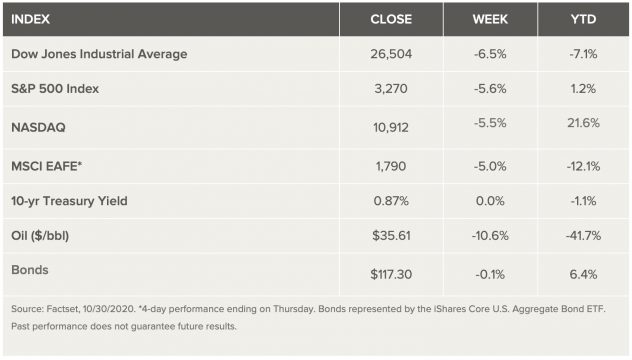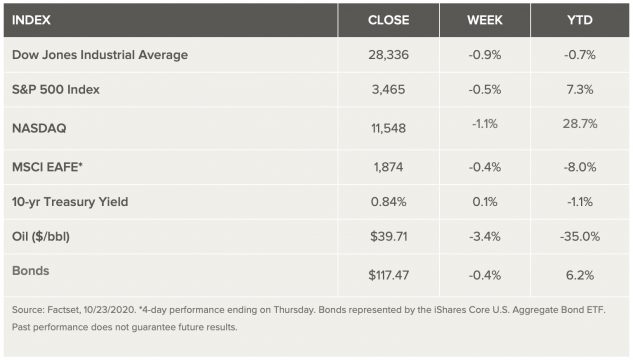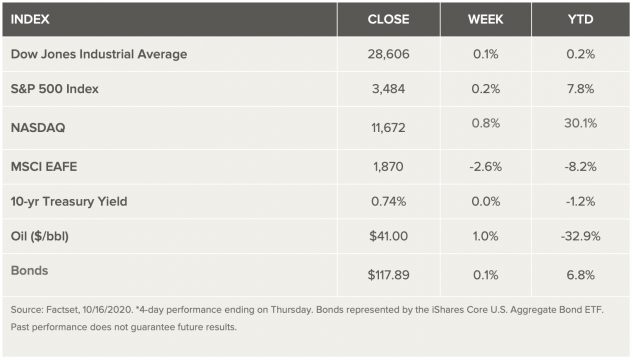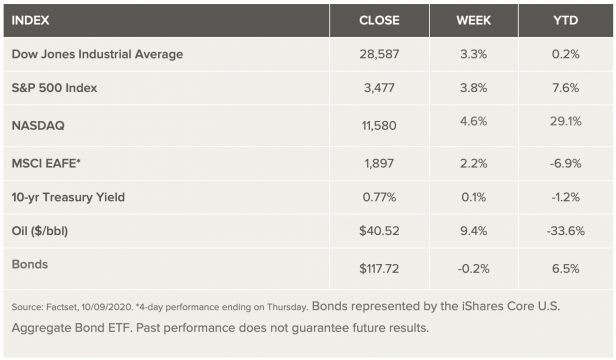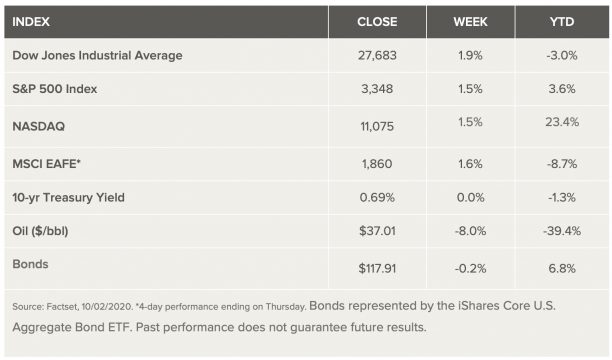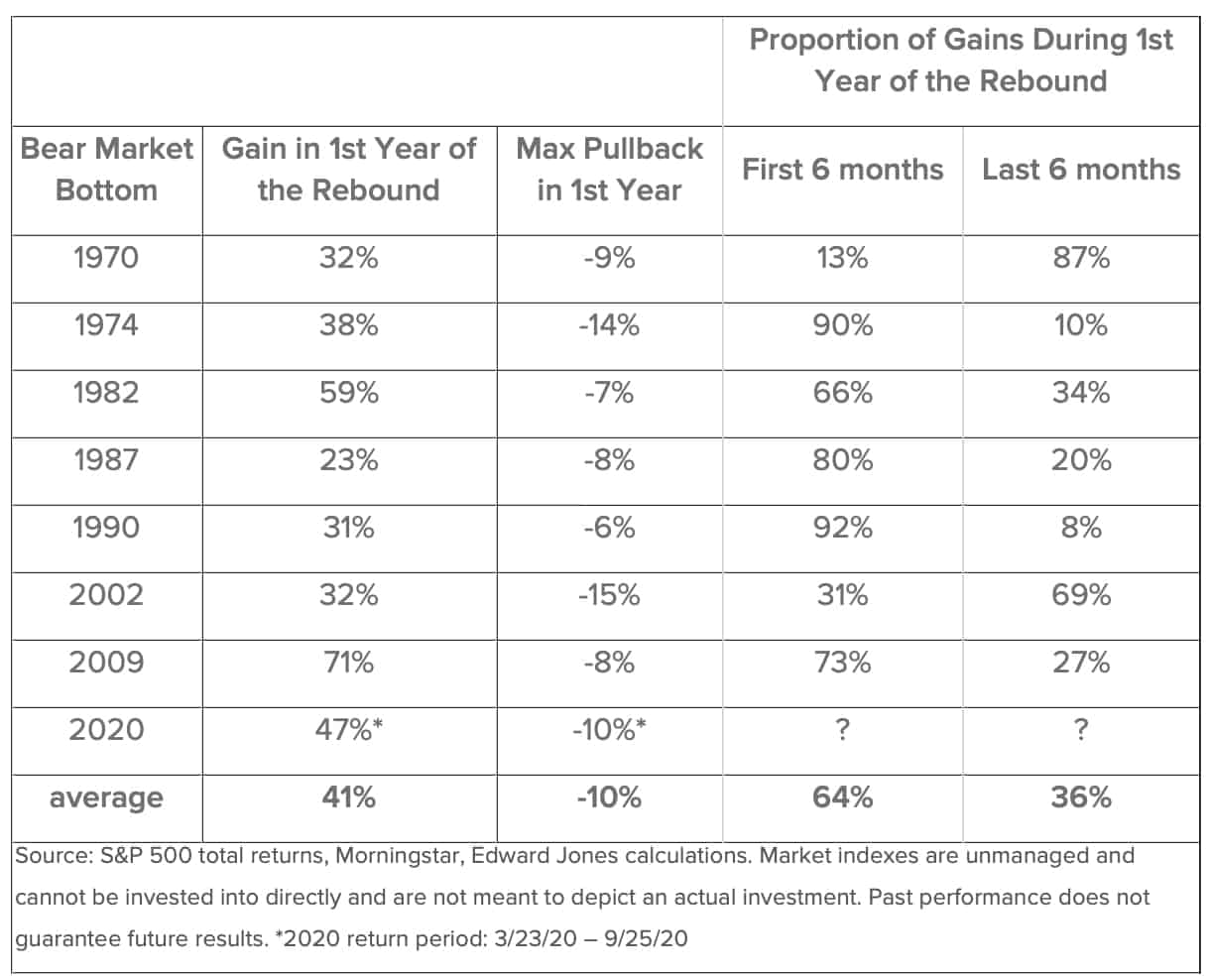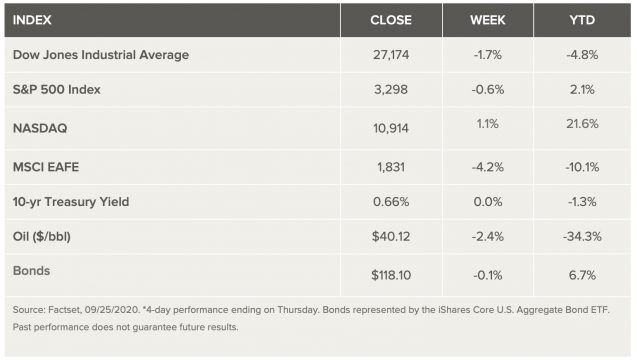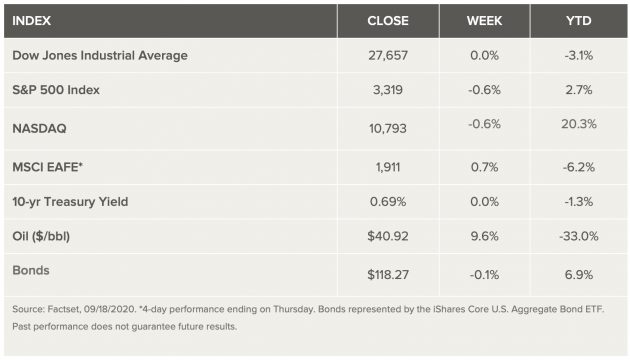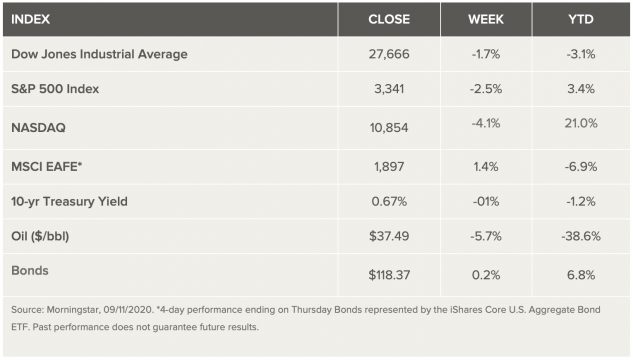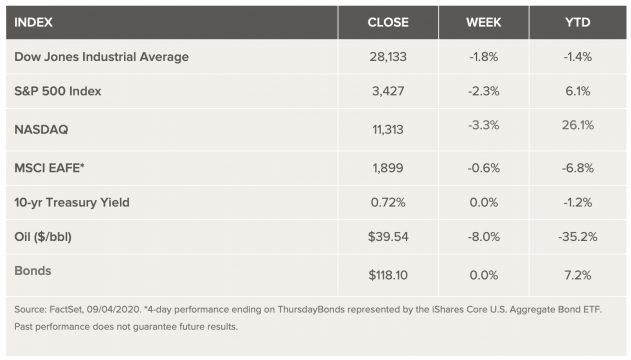Weekly Market Review – October 31, 2020
Stock Markets
Last week marked the 11th time this year that the S&P 500 has closed more than 2% lower than where it started the week, compared with a yearly average of around six times since 2010. The sell-off was largely driven by news that daily coronavirus cases have hit new record highs, and by less certainty that we will see another round of fiscal stimulus this year. Notably, the technology sector, which has been a leader for much of this bear-market rally, was down 6.5%, making it one of the leaders in the decline this week. Some good news was the strong third-quarter GDP growth, a labor market that is continuing to recover, and consumer spending that is continuing to exceed expectations.
US Economy
With days left before the U.S. election, a trifecta of worries around the political outcome, the path of the virus, and the lack of progress on another fiscal package weighed on stocks. The S&P 500 fell almost 6%, its worst weekly decline since March 20, and volatility jumped 40% from prior weeks’ levels. Analysts say this spike in volatility does not signal a 180-degree change in the long-term outlook for stocks, but rather reflects some nervousness around uncertainties that are likely to result in a slower, bumpier path ahead. However, they don’t think this uneasiness will derail the recovery.
Metals and Mining
Gold battled headwinds this week, falling below US$1,880 per ounce for the first time in four weeks. The US dollar rallied briefly but was reversing course by Friday. Uncertainty around the approaching US election paired with a rise in global COVID-19 cases weighed on investor sentiment, aiding in a late-week ascent for the yellow metal. The broader precious and base metals sectors also faced declines in the last week of the month, with palladium and nickel experiencing the largest decreases at 9 percent and 2.6 percent, respectively. Gold started the week holding just above US$1,900, edging as high as US$1,909 on Tuesday. But by Wednesday, a stronger US dollar index had added pressure, sending the price plummeting to US$1,872. And that wasn’t the end to the currency metal’s woes — the greenback’s move then forced gold even lower, to US$1,863. Despite the recent dip, most analysts expect gold to regain steam. Gerardo Del Real of Digest Publishing sees the drop-in value as a realignment and opening. Gold was priced at US$1,879 on Friday. The silver price shed as much as 7.3 percent this week, dropping as low as US$23.02 per ounce for the first time since September 21. Volatility across equity markets added pressure to the dual metal, which was weighed down by both its currency and industrial correlations. The white metal stands to benefit from infrastructure, stimulus and energy projects post-election, although it is likely to face headwinds until after the November 3 vote. Silver was trading for US$23.40 an ounce on Friday. Platinum also fell lower this week, losing 3.9 percent after edging to US$879 per ounce. Sluggish Q3 automotive sales and lingering supply chain challenges have depressed platinum prices, as well as prices for its metal sister palladium. Although Q3 auto sales rose 38 percent from the previous quarter, they are still down 10 percent year-over-year. Palladium was the precious metal facing the largest declines this period, dropping 9 percent. It sunk from US$2,264 on Tuesday to US$2,057 by early Friday. Platinum was valued at US$840 and palladium was selling for US$2,091 on Friday.
After reaching a year-to-date high of US$6,953 on October 21, copper has pulled back by 3.7 percent. Although the dip has lowered prices, the copper outlook remains optimistic. A recovery in China, which makes up the bulk of copper demand, looming supply shortages stemming from lockdowns in Peru and Chile and a weak US dollar are all potential catalysts for copper prices down the road. Copper was moving for US$6,692 per tonne on Friday morning. Zinc also experienced volatility for the last trading week of October. Like copper, zinc reached a year-to-date high of US$2,565 per tonne late in the month, then fell back. Prices remain above US$2,500, but according to analysts at the International Lead and Zinc Study Group (ILZSG), volatility could be ahead for both zinc and lead. 2020 is anticipated to bring a 5.3 percent fall in zinc demand, and a 6.5 percent decline for lead. Some of that is expected to be offset by output drops from top-producing nations Bolivia, Peru and Mexico. Zinc mine production is forecast to be down 4.4 percent, with a 4.7 percent decrease for lead. However, these two metals have also experienced severe supply disruptions as well. Zinc was priced at US$2,503 on Friday, while lead was trading for US$1,801 per tonne. Nickel spent the early part of the week edging higher to sit at US$15,819 per tonne on Wednesday. A day later, a dramatic drop sent prices to US$15,393, a 2.6 percent decline. The reversal is linked to a market correction after the metal marked its year-to-date high of US$16,064 on October 21. Nickel’s October rally has been attributed to a recovery in the stainless-steel market, and that could help keep prices above US$15,000 into next year. On Friday morning, nickel was valued at US$15,393.
Energy and Oil
Oil prices plunged this week after spending months trapped in a narrow range around $40 per barrel. Renewed national lockdowns in France and Germany rattled financial markets, while the U.S. case count for covid-19 remained at record levels and may continue to rise. “As lockdowns begin to bite on demand concerns across Europe, the near-term outlook for crude starts to deteriorate,” said Stephen Innes, chief global market strategist at Axi. In early trading on Friday, WTI fell to $35 per barrel and Brent was at $37. It seems that OPEC members are reluctant to extend cuts. Three of the biggest OPEC producers behind Saudi Arabia may not be on board with extending the current cuts into next year. Iraq, the United Arab Emirates (UAE), and Kuwait are reportedly not particularly inclined to support a rollover of the cuts of 7.7 million barrels per day (bpd), because such cuts are too deep for their economies and budget incomes to sustain.
Natural gas spot prices rose at most locations this week. The Henry Hub spot price rose from $2.86 per million British thermal units (MMBtu) last week to $3.06/MMBtu tis week. At the New York Mercantile Exchange (Nymex), the November 2020 contract expired at $2.996/MMBtu, down 3¢/MMBtu from last week. The December 2020 contract price decreased to $3.291/MMBtu, down 6¢/MMBtu from last week to this week. The price of the 12-month strip averaging December 2020 through November 2021 futures contracts declined 3¢/MMBtu to $3.108/MMBtu.
World Markets
Shares in Europe tumbled the most since their March swoon, as investors worried that lockdowns aiming to control the coronavirus’ spread could push the eurozone economy into a double-dip recession. Political uncertainty in the U.S. also weighed on sentiment. In local currency terms, the pan-European STOXX Europe 600 Index ended the week 5.56% lower, while Germany’s DAX Index dropped 8.61%, France’s CAC 40 lost 6.42%, and Italy’s FTSE MIB slid 6.96%. The UK’s FTSE 100 Index declined 4.83%.
Core eurozone bond yields fell on the week. The yield on Germany’s 10-year sovereign bonds declined, as the country and France reintroduced national lockdown restrictions to combat rising coronavirus cases. Dovish messaging from the European Central Bank (ECB) after its policy meeting on Thursday also helped to support prices and compress yields on core eurozone bonds. Peripheral bond yields fluctuated. Yields in Spain and Italy drifted higher early in the week, as investors shied away from risk; however, yields on these bonds moved lower after the ECB reiterated its commitment to easier monetary policy. UK gilt yields followed their developed market counterparts lower.
Chinese stocks fell in sympathy with the downturn on Wall Street, with the benchmark Shanghai Composite Index declining 1.6% and the large-cap CSI Index shedding 0.5%. The yield on the 10-year sovereign bond ended flat at 3.20%, and the dollar-renminbi currency exchange rate stayed broadly stable. In currency news, the People’s Bank of China (PBOC) asked domestic banks to suspend the use of a so-called countercyclical factor (CCF) in fixing the renminbi’s daily midpoint against the U.S. dollar, Reuters reported. The CCF—which is an adjustment made by contributing banks to influence the value of the yuan—was introduced in 2017 as a tool to dampen excessive currency volatility. The PBOC’s move to neutralize the CCF was interpreted as allowing the renminbi, which is tightly managed by the central bank, to become more market-driven.
The Week Ahead
Important economic data being released this upcoming week include the Unemployment Rate, the Fed’s upper bound key interest rate, and various PMI series.
Key Topics to Watch
- Markit manufacturing PMI (final)
- ISM manufacturing index
- Construction spending
- Election Day
- Factory orders Sept.
- Motor vehicle sales (SAAR)
- ADP employment report
- Trade deficit
- Markit services PMI (final)
- ISM services index
- Initial jobless claims (regular state program, SA)
- Initial jobless claims (federal & state, NSA)
- Continuing jobless claims (regular state program, SA)
- Continuing jobless claims (federal & state, NSA)
- Productivity
- Unit labor costs
- Federal Reserve meeting announcement
- Fed Chair Jerome Powell news conference
- Nonfarm payrolls
- Unemployment rate
- Average hourly earnings
- Wholesale inventories
- Consumer credit
Market Summary
